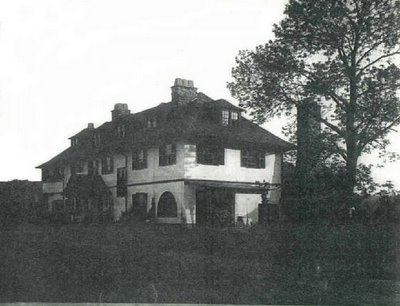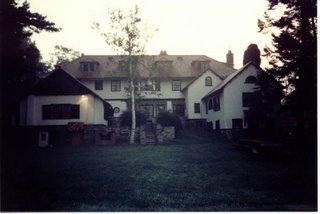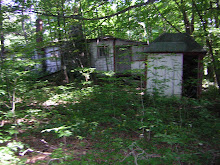
Fernbrook- early 20th century (courtesy of Gray Locke>
Lenox, Massachusetts is well known for the many mansions built there by wealthy citizens during the Gilded Age. Given their history and square footage, it is perhaps not surprising that there are stories of ghostly residents attached to several of them.
One such residence is to be found in the building now known as High Point on West Mountain Road, currently in use as one of the Hillcrest Educational Center sites. Though much smaller than many of the Gilded Age "cottages," it has nonetheless afforded plenty of space for mysterious happenings.
Originally known as Fernbrook, this house was constructed between 1901 and 1902, as a residence and studio for Thomas Shields Clarke. Clarke was an aristocrat, and a painter and sculptor of some considerable renown, who had exhibited and won awards in Berlin, Paris, London and Madrid. His work was much in demand at that time, and some of his larger bronze and marble works adorn public places in New York, San Francisco, Chicago and other cities.
The cottage itself was designed by Philadelphia architect Wilson Eyre, in the style of a Tyrolean Gothic villa. It was built to contain a spacious studio, modeled after the refectory of a monastery in Sicily, as well as an elaborate library, 13 bedrooms, three baths and six fireplaces. After Clarke died in 1920, the estate was sold to Dr. Robert Metz, who later passed it on to Paul Schmidinger.
Fernbrook has been mentioned for years in a number of "Haunted Places" reference books, accompanied by extremely brief entries. I have never seen more than a sentence or two devoted to it in print, typically just some vague mention of strange noises heard in the house. Fortunately, Robert Gorden of Becket, who worked there for a number of years, was able to shed a great deal more light on its ghoulish history for me.
 Fernbrook circa 1920 rear of house.
Fernbrook circa 1920 rear of house.Gorden revealed that talk of a ghost went back several decades, to around the time Dr. Metz acquired the property, and perhaps even earlier. Over the years, quite a few people had discussed hearing and seeing strange things around the house. Most of the strangest, according to Gorden, seemed to be localized around the area of the basement. Doors that had been left firmly shut would spring open, and from his workshop there he could hear a sound like someone moaning or crying.
"Sometimes I would come around a corner and have the sense that someone or something had just turned the corner ahead of me, or gone through the door," he said. "I don't think I actually 'saw' anything but I often felt that I did, or had just missed someone."
Another employee, a housekeeper there, also had a variety of strange experiences. Her room was also in the basement, beside what had been the original laundry area, and from there she could plainly hear a woman's cries. Doors would slam suddenly and cold drafts would rise up, apparently out of nowhere. On one particularly frightening occasion, she said, she had even seen an apparition of woman pass by, covered all in white.
Curious about the phenomenon, Gorden mentioned it to Paul Schmidinger, who had first come there to work for Dr. Metz in 1937. Metz had said that he'd been told by past servants at the house that Clarke had had an affair with a Welsh girl named Anghorad, who served as the under-house parlor maid. At some point, the girl became pregnant and months later she died. Her body was found in the laundry room, having perished either from a miscarriage or botched abortion attempt, according to rumor.
This story intrigued me, and I wondered whether there might be any historical documentation that might help confirm this sequence of events. There is not a huge amount of information available about Clarke's time in Lenox. What is known is that he stayed at Fernbrook, from May to October, every year from 1904 to 1920. As for the girl, a check of the town's death records for those years failed to turn up mention of anyone listed by that name. The historical record is incomplete, and it is probably safe to say that this was the sort of thing the aristocratic Clarke would not have wanted widely known.
In the end, though, it's pure speculation, and hardly the sort of thing to hang a man's reputation on. Maybe there was no Anghorad; maybe something completely different happened. It could be that the story simply grew more sordid as it was passed around by the house staff. In any case, it makes a compelling narrative, which, as far it goes, helps to explain reports of unusual experiences there over the years.
 High Point circa 1990 (courtesy of Gray Locke)
High Point circa 1990 (courtesy of Gray Locke)The house changed hands more rapidly after Metz died in the late '40s. Schmidinger sold it in 1956 to Florence Davis, who resold it soon after. Doris Barden turned it into "High Point Art Gallery and Inn," which operated for a few years, before the cottage came to its current use in the 1970s. I've been unable to obtain any information from anyone at Hillcrest regarding the house or its reputation, so I've no idea whether or not any strange occurrences ever come up. Perhaps whatever unpleasantness hung over the place has faded away - or perhaps doors still open, unseen, in the basement.


